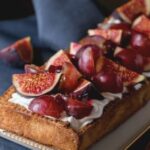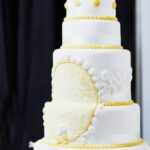Flowers have long been a popular choice for decorating cakes, adding a touch of natural beauty and elegance to these delicious treats. Whether it’s a birthday, wedding, or any other special occasion, cake flowers can instantly elevate the design and make it more visually appealing.
In this article, we will explore the various types of edible flowers that are perfect for cake decoration, as well as provide a step-by-step guide on how to choose and prepare them. We will also showcase some popular flower cake designs and ideas, along with techniques for arranging flowers on cakes using fondant or buttercream.
Additionally, we will share tips and tricks for piping flower designs on cakes, and discuss how fresh flowers can be used to enhance cake decorations. Finally, we will highlight some common mistakes to avoid when decorating cakes with flowers, ensuring that your floral creations are as stunning as they can be. So let’s dive in and discover how you can bring floral elegance to your cake decoration with beautiful flowers.
Types of Edible Flowers for Cake Decoration
Edible flowers add a beautiful and unique touch to cake decoration, making them a popular choice for special occasions such as weddings, birthdays, and anniversaries. When choosing edible flowers for cake decoration, it is important to select ones that are safe to consume and will complement the overall design of the cake. Here are some popular types of edible flowers that are commonly used for cake decoration:
- Roses: Roses come in various colors and sizes, making them versatile for cake decoration. They have a delicate flavor and can be used as whole blooms or as petals.
- Pansies: Pansies are known for their vibrant colors and playful appearance. They have a slightly sweet flavor and can be used as individual blossoms or scattered on the cake.
- Marigolds: Marigolds add a pop of bright orange or yellow color to cakes and have a slightly citrusy taste. They can be used as whole flowers or as separated petals.
- Lavender: Known for its calming scent, lavender is often used as an accent flower on cakes. It has a floral taste with hints of mint and citrus.
- Violets: Violets come in various shades of purple and have a subtle floral flavor. They are delicate and can be used as whole blossoms or individual petals.
It is important to note that not all flowers are suitable for consumption, so it is crucial to do thorough research before using any type of flower on cakes. It is recommended to use organic flowers that have been grown without the use of pesticides or harmful chemicals. Additionally, flowers should be cleaned thoroughly before use by removing dirt, insects, and any non-edible parts such as stems or leaves.
To ensure food safety, it is advisable to check with the florist or supplier if the flowers have been treated with chemicals, which could make them unsafe for consumption. Furthermore, it is essential to inform guests about the presence of edible flowers on the cake, especially if they have any allergies or dietary restrictions.
Step-by-Step Guide
Step 1: Choosing Edible Flowers
When it comes to decorating cakes with flowers, it is crucial to choose the right type of edible flowers. Not all flowers are safe for consumption, and some may even be toxic. It is essential to select flowers that are specifically labeled as edible or culinary flowers. These can typically be found at specialty food stores, farmers markets, or through online retailers. Popular edible flower options include roses, pansies, marigolds, violets, and lavender.
Before using the flowers on your cake, it is important to ensure they have not been sprayed with any chemicals or pesticides. If you are purchasing edible flowers from a store or market, ask the vendor about their cultivation methods to guarantee that they are safe for consumption. Alternatively, if you have access to organically grown flowers in your garden or from a trusted source, you can use those as well.
Step 2: Preparing Edible Flowers
Once you have selected your edible flowers, it is vital to prepare them properly before placing them on your cake. Start by gently washing each flower under cool water to remove any dirt or potential bugs. Use a soft brush or paper towel to carefully dry the petals without causing damage.
Next, remove any unwanted parts of the flower such as stems, leaves, and pistils (the central part of the flower). These parts are not typically consumed and can detract from the overall appearance of the cake design.
Lastly, consider preserving your edible flowers by lightly brushing them with an egg white wash. This will provide a glossy finish and help prolong their lifespan on the cake. To make an egg white wash, beat one egg white until foamy and then gently brush it onto each flower using a small paintbrush.
Step 3: Placing Flowers on Your Cake
Now that your edible flowers are ready, it’s time to place them onto your cake in a visually appealing arrangement. Start by determining the overall design and positioning you desire for the flowers. You can choose to concentrate the flowers in a certain area of the cake or create a scattered effect.
To attach the edible flowers to your cake, simply press them gently into the frosting or buttercream. The moisture from the frosting will help adhere the flowers securely to the cake surface. Be cautious not to insert them too deeply, as some parts of the flower may be slightly bitter and affect the taste of the cake. Consider using extra frosting or a small amount of melted white chocolate as an adhesive if needed.
Remember that not all parts of every flower are edible, so make sure to communicate this to your guests before serving. It is also recommended to remove any flowers from slices before eating unless they are known to be fully edible.
By following these step-by-step instructions for choosing and preparing edible flowers, you can confidently add a beautiful floral touch to your cake that will surely impress your guests with its elegance and taste.
Popular Flower Cake Designs and Ideas
When it comes to decorating cakes with flowers, there are endless possibilities for creative and beautiful designs. Whether you are looking for something elegant, whimsical, or modern, there is a flower cake design that is perfect for your occasion. Here are some popular flower cake designs and ideas to inspire you:
- Floral Cascade: This design features a cascade of flowers flowing down the side of the cake. It creates a romantic and whimsical look that is perfect for weddings or other special occasions. Choose flowers in different sizes and colors to create depth and visual interest.
- Naked Cake with Fresh Flowers: The naked cake trend has gained popularity in recent years, and adding fresh flowers to it takes it to the next level. By using minimal frosting, the focus is on the natural beauty of the flowers. This design is perfect for rustic or bohemian-themed weddings.
- Ombre Flower Cake: Ombre cakes have become increasingly popular, and adding flowers enhances their beauty even more. Create a gradient effect by using flowers in different shades of one color, such as pink or purple. This design adds a touch of elegance to any celebration.
- Floral Wreath: A floral wreath design involves arranging flowers in a circular pattern on top of the cake, creating a stunning centerpiece. Choose small blooms in various colors that complement each other well.
- Watercolor Flower Cake: Watercolor-inspired cakes have become trendy recently, and incorporating floral designs further enhances their artistic appeal. Paint delicate watercolor flowers onto buttercream-frosted cakes using food-safe paint brushes or edible ink pens.
These are just a few examples of popular flower cake designs and ideas that can transform an ordinary cake into a stunning centerpiece for any occasion.
| Flower Cake Design | Description |
|---|---|
| Floral Cascade | A cascade of flowers flowing down the side of the cake, creating a romantic and whimsical look. |
| Naked Cake with Fresh Flowers | A minimal frosting cake decorated with fresh flowers, perfect for rustic or bohemian-themed weddings. |
| Ombre Flower Cake | A gradient effect created by using flowers in different shades of one color, adding elegance to any celebration. |
| Floral Wreath | Flowers arranged in a circular pattern on top of the cake, creating a stunning centerpiece. |
| Watercolor Flower Cake | Delicate watercolor-inspired flowers painted onto buttercream-frosted cakes using food-safe paint brushes or edible ink pens. |
Techniques for Arranging Flowers on Cakes
Arranging flowers on a cake is not only aesthetically pleasing but also adds a touch of elegance and freshness to any dessert. The proper arrangement of flowers can transform an ordinary cake into a stunning centerpiece. In this section, we will discuss various techniques for arranging flowers on cakes and provide some useful tips to help you create beautiful floral designs.
Selecting the Right Flowers
Before arranging the flowers on your cake, it is essential to choose the right type of flowers that are safe for consumption. Edible flowers such as roses, pansies, marigolds, and violets are popular choices for cake decoration. Ensure that the flowers are organic, pesticide-free, and haven’t been treated with any harmful chemicals or dyes. It’s important to note that not all flowers are safe to eat, so do thorough research before incorporating any decorations onto your cake.
Preparing the Flowers
To prepare the flowers for cake decoration, gently rinse them under cool water to remove any dirt or insects. Allow them to air dry completely before handling. If you want to preserve the freshness of your flower decorations and prevent them from wilting too quickly, consider refrigerating them until just before serving.
Proper Placement
The placement of flowers on a cake depends on personal creativity and design preferences. One popular technique is to create a cascade effect by placing larger blooms at the top of the cake and allowing smaller blooms or sprigs to fall down towards the sides or edges. Alternatively, you can arrange smaller blossoms in clusters or create a wreath-like pattern around the perimeter of the cake.
Remember that when using fresh flowers for decoration, it’s crucial to insert stems securely into the cake without actually touching the edible portion if possible. To ensure food safety, wrap each stem with floral tape or insert them into plastic tubing before inserting them into the cake. This will prevent any direct contact between the flowers and the cake.
Knowing different arrangements and techniques for arranging flowers on cakes allows you to produce stunning floral designs that will impress your guests. However, it’s essential to remember that not all flowers are edible or safe to use for decoration. Always do thorough research, consult with experts if needed, and ensure proper handling and placement of your floral decorations on your cake to guarantee both safety and beauty.
Using Fondant or Buttercream Flowers for Cake Decoration
When it comes to cake decoration, using fondant or buttercream flowers can add an extra level of elegance and creativity. These edible flowers are not only visually appealing but also provide a unique and delicious element to your cake design. Whether you’re a professional baker or just trying your hand at cake decorating, using fondant or buttercream flowers can take your creations to the next level.
Fondant Flower Technique
- Start by preparing a batch of fondant in the desired color for the flowers. You can either buy pre-made fondant or make it from scratch using marshmallows and powdered sugar.
- Roll out the fondant on a clean, flat surface using a rolling pin. Make sure to dust the surface with powdered sugar to prevent sticking.
- Use flower-shaped cookie cutters in various sizes to cut out the petals from the rolled fondant. Press down firmly and lift the cutter away gently to maintain the shape.
- Place each petal on a foam pad and use a ball tool to thin out the edges and give them a natural curve. This will add dimension and realism to your flowers.
- To create the center of the flower, roll a small ball of fondant between your palms and flatten it slightly with your fingers. Attach it to the center of the petals using edible glue or water as an adhesive.
- Continue adding petals around the center, slightly overlapping each one until you achieve the desired fullness for your flower.
- Once all petals are in place, use edible dusting powder or gel food coloring mixed with clear alcohol (such as vodka) to add color and depth to your flowers.
Buttercream Flower Technique
- Prepare different colors of buttercream icing by adding food coloring gel or paste into separate bowls of white buttercream frosting.
- Attach a petal piping tip to a piping bag and fill it with one color of buttercream frosting. Hold the piping bag at a 45-degree angle and pipe a small mound of icing onto the cake, creating the center of the flower.
- Switch to a different petal piping tip and another color of frosting. Start piping petals around the center, applying pressure and gently pulling away to create a curved shape. Repeat this step with different colors to build up layers of petals for a realistic flower.
- Use leaf tips and green buttercream frosting to pipe leaves around the base of your flowers, adding an extra touch of detail and dimension.
- To add more depth and realism to your buttercream flowers, you can use edible dusting powder or food coloring mixed with clear alcohol to paint details on each petal.
Whether you choose fondant or buttercream flowers for your cake decoration, practice is key. Experiment with different shapes, colors, and techniques to create stunning floral designs that will wow any crowd. Remember to store these delicate flowers properly until they are ready to be placed on the cake for lasting freshness and beauty.
Tips and Tricks for Piping Flower Designs on Cakes
Piping flower designs on cakes is a popular technique that adds a beautiful and intricate touch to cake decorations. With the right tips and tricks, you can create stunning floral designs that will wow your guests. Here are some helpful tips to keep in mind when piping flower designs on cakes:
Choose the Right Piping Tips
Firstly, it’s important to select the right piping tips for creating flower designs on cakes. Different piping tips will create different flower shapes and styles. For example, a petal tip or a rose tip can be used to create realistic-looking petals, while a star tip can be used for small flowers or stamens. Experiment with different tips to achieve the desired effect.
Use the Right Consistency of Buttercream
The consistency of your buttercream icing is crucial when piping flower designs on cakes. If the buttercream is too stiff, it will be difficult to pipe smooth and delicate petals. On the other hand, if it is too soft, the flowers may lose their shape and definition. To achieve the ideal consistency, start with slightly softened butter and gradually add powdered sugar until you reach a smooth and pipeable texture.
Practice Pressure Control
Piping flower designs requires good control over pressure to achieve varying thicknesses of petals and smooth lines. Practice applying consistent pressure as you pipe to create even petals and avoid any breaks in the design. It’s also essential to release pressure gradually when finishing each petal or flower shape for a cleaner look.
Tips
- Start practicing by piping simple flowers on parchment paper before attempting them directly on a cake.
- Clean your piping tips regularly during use for neat and crisp flower designs.
- Use gel food coloring instead of liquid coloring for vibrant colored flowers.
By following these tips and tricks, you’ll be well on your way to creating stunning flower designs on cakes. Remember, practice makes perfect, so don’t be discouraged if your first attempts aren’t flawless. With time and patience, you’ll master the art of piping flower designs and bring a touch of elegance to your cake decorations.
Enhancing Cake Decorations with Fresh Flowers
Using fresh flowers to enhance cake decorations can add a touch of natural beauty and elegance to any occasion. Fresh flowers provide a vibrant and fragrant element to cake designs, elevating them from ordinary to extraordinary. Whether you are decorating a wedding cake, birthday cake, or any other special cake, incorporating fresh flowers can create a stunning visual display that will leave your guests in awe.
When using fresh flowers for cake decoration, it is important to choose flowers that are safe for consumption. Not all flowers are edible, and some can even be toxic if ingested. It is crucial to do your research and only select flowers that are designated as edible. Some popular options for edible flower decorations include roses, pansies, violets, marigolds, and lavender.
Before using fresh flowers on cakes, it is important to properly prepare them. Start by washing the flowers thoroughly to remove any dirt or pesticides. Gently pat them dry before placing them on the cake. It is also advisable to remove any leaves or thorns from the stems of the flowers before placing them on the cake. This ensures that no unwanted elements come into contact with the cake itself.
To enhance the visual impact of the fresh flower decorations on your cakes, consider incorporating different techniques for arranging them. One popular technique is cascading flower arrangements, where the flowers flow down the sides of the cake in an elegant manner. Another option is to create clusters or groupings of flowers in one area of the cake for a more concentrated burst of color and texture.
Common Mistakes to Avoid When Decorating Cakes with Flowers
Decorating cakes with flowers can add a beautiful and elegant touch to any special occasion. However, there are some common mistakes that people often make when it comes to incorporating flowers into their cake decorations. It is important to be aware of these mistakes in order to ensure that your cake looks its best.
One common mistake is not properly preparing the flowers before placing them on the cake. It is crucial to thoroughly wash and dry the flowers, ensuring that they are free from dirt, pesticides, or any other contaminants. This will help to prevent any potential health risks and also keep the flowers looking fresh on the cake.
Another mistake to avoid is using toxic or non-edible flowers on the cake. Some flowers may look beautiful, but they may be poisonous if ingested. It is essential to only use edible flowers that are safe for consumption. Popular edible flower options include roses, lavender, violets, pansies, and marigolds.
One more mistake that many people make when decorating cakes with flowers is not considering the compatibility of the flower with the cake design and flavor. It is important to choose flowers that complement the overall appearance and theme of the cake. Additionally, consider whether the flavors of the flower will harmonize with the flavor profile of the cake itself.
By being aware of these common mistakes and taking steps to avoid them, you can ensure that your floral cake decorations turn out beautifully and safely. Taking care in choosing and preparing edible flowers, as well as considering their compatibility with your cake design and flavor, will help you create a stunning centerpiece for any special occasion.
Conclusion
In conclusion, decorating cakes with flowers brings a touch of floral elegance that can elevate any cake design. The use of edible flowers adds not only visual appeal but also unique flavors and aromas to the cake. By following a step-by-step guide and selecting the right flowers for decoration, anyone can create stunning flower cake designs.
There are various techniques for arranging flowers on cakes, including using fondant or buttercream flowers. These methods allow for more detailed and intricate designs that can truly make a cake stand out. Piping flower designs with tips and tricks adds another dimension to the decoration, creating beautiful textures and patterns that mimic real flowers.
One way to enhance cake decorations with flowers is by incorporating fresh flowers alongside edible ones. Fresh flowers bring a natural beauty and freshness to the presentation, making it even more visually striking. However, it’s important to exercise caution when using fresh flowers and ensure they are safe for consumption.
Frequently Asked Questions
How to decorate flowers on a cake?
Decorating flowers on a cake can add a beautiful touch and elevate its overall appearance. To start, you will need to have prepared buttercream or fondant in various colors. Begin by tinting the frosting or fondant with food coloring to achieve the desired shades for your flowers. Then, using flower-shaped cookie cutters or piping tips, cut out or pipe the flowers onto a piece of parchment paper.
Allow them to harden slightly before carefully transferring them onto the cake. You can use an offset spatula or tweezers to gently place the flowers in your preferred arrangement on top of the cake. It’s essential to ensure that the flowers are securely attached, so they don’t fall off while serving or transporting the cake.
What flowers do you use to decorate a cake?
When it comes to choosing flowers to decorate a cake, it is crucial to opt for edible varieties that are safe for consumption. Some commonly used edible flowers for cake decoration include roses, pansies, violas, marigolds, and lavender blossoms—to name just a few.
It’s essential always to use organic and pesticide-free flowers when decorating cakes and verify that they are indeed suitable for consumption. Be sure to thoroughly clean and inspect each flower before placing it on the cake.
How to make decorative flowers for cakes?
Creating decorative flowers for cakes allows you to customize your design and impressively enhance the cake’s presentation. To make edible decorative flowers, you will need gum paste or fondant mixed with tylose powder—a substance that helps stiffen it up for shaping purposes—food coloring in various shades, as well as some tools like petal cutters and foam pads. Start by kneading small amounts of gum paste/fondant together with tylose powder until it becomes pliable yet firm enough to hold its shape once molded into flower petals or leaves. Roll out the gum paste/fondant thinly using a rolling pin dipped in cornstarch or powdered sugar to prevent sticking.
Use petal cutters to stamp out shapes and then gently thin the edges of each petal by placing it on a foam pad and using a ball tool to create a slight frill effect. Assemble multiple petals together, attach them at the base with edible glue or water, and shape them further with your fingers to resemble real flowers. Allow them to dry on a foam pad or in flower formers before placing them on the cake.

Welcome to my blog about home and family. This blog is a place where I will share my thoughts, ideas, and experiences related to these important topics. I am a stay-at-home mom with two young children. I hope you enjoy reading it! and may find some helpful tips and ideas that will make your home and family life even better!





